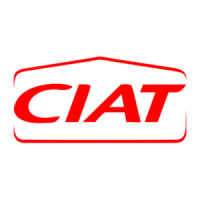
Do you have a question about the CIAT XtraConnect 2 and is the answer not in the manual?
| Brand | CIAT |
|---|---|
| Model | XtraConnect 2 |
| Category | Control Unit |
| Language | English |
Details the electrical power supply requirements for the unit and remote control.
Lists the technical specifications of the XTRACONNECT 2 control board, including fuse.
Highlights critical safety instructions and precautions for servicing the product, including battery replacement.
Details the requirements for proper earthing of the unit for electrical safety compliance.
Explains how to connect sensor cables, including routing and shielding for interference prevention.
Provides instructions for connecting communication buses and remote consoles, including cable specs.
Describes the connection methods for on/off inputs, considering cable distances and relays.
Provides a general overview of the Xtraconnect 2 control module and its functions.
Explains how to select and manage user access levels on the controller.
Details the procedure for accessing different access levels, including codes.
Describes how to navigate through the main menu options using the console buttons.
Explains how to access and adjust setpoint values based on operating mode.
Details how to view the current status of the unit and fault messages.
Explains the function of the automatic machine operation control input.
Details the automatic water pump control input and its effect on the machine.
Explains discharge fault detection based on pipe temperature and shutdown logic.
Monitors evaporator water inlet temperature for unit adjustment and fault detection.
Monitors evaporator water outlet temperature for frost protection and fault detection.
Monitors manifold water outlet temperature for unit adjustment and fault detection.
Monitors master/slave water outlet temperature for unit adjustment and fault detection.
Monitors outdoor air temperature for system adjustment and fault detection.
Monitors hydraulic module air temp for defrost heater control and fault detection.
Monitors condenser water temperature for heating adjustment and fault detection.
Monitors compressor discharge temperature for safety and fault detection.
Monitors suction temperature for superheat calculation and fault detection.
Measures liquid temperature for subcooling calculation and fault detection.
Explains pump operation for single-pump configurations in cooling and heating modes.
Details pump operation for two-pump configurations, including unseizing.
Explains pump operation with fault management in cooling mode.
Details two-pump operation with fault management and runtime balancing.
Describes the operation of the hydraulic module defrost heater based on temperature.
Explains the operation of the evaporator pipe heat trace cable based on outdoor temperature.
Details the evaporator water freezing protection and its setpoints.
Explains compressor starting order, runtime balancing, and stage management.
Details the short-cycle protection function and its limit on compressor starts.
Explains how to use the function to disable a specific compressor via the Adjustment Parameters menu.
Describes how to display runtimes and start-up counts for compressors and pumps.
Explains the oil warm-up time delay after a power cut to protect compressors.
Details how electrical quantities are retrieved and displayed via the controller.
Sets minimum heating air temperature limit for water-to-water units.
Sets maximum heating air temperature limit for water-to-water units.
Sets maximum cooling air temperature limit for the unit.
Sets minimum cooling air temperature limit for the unit.
Describes the fundamental operating principles of master/slave control.
Provides general information and considerations for master/slave configurations.
Details functions like priority, runtime balancing, and backup machine management.
Details how the slave machine's operating mode is determined by the master.
Explains how control setpoints are calculated in master/slave configurations.
Describes how return control operates when the master machine is unavailable.
Details the sensor requirement for supply control in master/slave setups.
Explains the cascade control logic for parallel-connected machines.
Explains the main control principle for cooling and heating modes.
Details setpoint calculation for single setpoint configuration based on outdoor sensor.
Explains setpoint selection via console for cooling and heating modes.
Details setpoint selection via on/off input for cooling and heating modes.
Explains setpoint configuration using a 4-20mA input signal.
Details slope adjustment in cooling mode based on outdoor air temperature.
Details slope adjustment in heating mode based on outdoor air temperature.
Explains modulating control for a single compressor based on water temperature.
Details modulating control for three compressors based on water temperature.
Explains staged control for air-cooled condensers and fan operation.
Details HP control with acoustic optimization for fan speed.
Details HP control with energy optimization for fan speed.
Explains the compressor start-up sequence and the anti-short-cycle function.
Details high pressure operation limits and compressor capacity reduction.
Explains water freeze limit and compressor capacity reduction when water temp drops.
Details evaporator freeze limit and its effect on compressor output and shutdown.
Explains power input limitation function for managing total power consumption.
Provides an overview of the time schedules function, including program steps and holiday bands.
Details how to define program steps, including start/end times and control modes.
Explains how to define holiday bands for specific periods of machine operation.
Describes how schedules and holiday bands affect unit operation and settings.
Details the RS485 communication interface, connectors, and LEDs.
